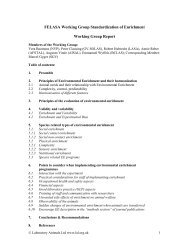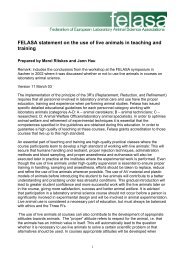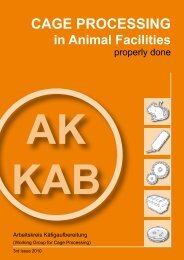CAGE PROCESSING in Animal Facilities - Felasa
CAGE PROCESSING in Animal Facilities - Felasa
CAGE PROCESSING in Animal Facilities - Felasa
- No tags were found...
You also want an ePaper? Increase the reach of your titles
YUMPU automatically turns print PDFs into web optimized ePapers that Google loves.
IVC systemsIndividually ventilated cages. This means cage systems for hygienic/allergic protection of animals and humans/surround<strong>in</strong>gs.To achieve this protection, cage bases are closed and locked with tops. Individual ventilationsystems allow for a proper air supply of the animals.LAFLam<strong>in</strong>ar-Air-FlowLoad<strong>in</strong>g trolleyA load<strong>in</strong>g trolley is a mobile rack for load<strong>in</strong>g and mov<strong>in</strong>g different types of items <strong>in</strong>to a washer or steriliser.Different types of items and mach<strong>in</strong>es require different types of load<strong>in</strong>g trolleys.MAC valueThe MAC value <strong>in</strong>dicates the maximum allowable concentration of hazardous substances <strong>in</strong> form of gas,steam, or aerosols <strong>in</strong> workplace air that, accord<strong>in</strong>g to current knowledge, pose no risk to the health of employeesand are no major disturbance either, even with employees be<strong>in</strong>g exposed to them over a longer period,which means a work time of eight hours a day.MediaThis term sums up all utilities (usually steam and water) and process chemicals.Occupational risk assessmentA workplace should be as low risk as possible. Therefore, every employer is to conduct a risk assessment ofthe possible threats posed <strong>in</strong> every job he/she offers. For pr<strong>in</strong>ciples and methods of occupational risk assessment,please consult the labour protection act, ord<strong>in</strong>ance on <strong>in</strong>dustrial safety and health, and ord<strong>in</strong>ance onhazardous substances as def<strong>in</strong>ed by your respective country. The aspects described below should be considered<strong>in</strong> particular:• risks that occur with general job work, for example <strong>in</strong> the course of certa<strong>in</strong> work procedures (assessmentof the entire work rout<strong>in</strong>e – “synopsis”: selection/comb<strong>in</strong>ation/<strong>in</strong>teraction of different mach<strong>in</strong>es, hazardoussubstances, physical position<strong>in</strong>g, employee skills, etc.),• risks that occur when work<strong>in</strong>g with hazardous substances, like detergents and dis<strong>in</strong>fectants (protectionlevel concept),• risks that occur when handl<strong>in</strong>g work equipment, like mach<strong>in</strong>es, <strong>in</strong> <strong>in</strong>teraction with, for example, hazardoussubstances,• test <strong>in</strong>tervals for mach<strong>in</strong>e parts, mach<strong>in</strong>es, and the overall system.Details on occupational risk assessment can also be found <strong>in</strong> the guidel<strong>in</strong>es of government safety organisationsor of the regional authorities charged with the pr<strong>in</strong>ciples and methods of occupational safety.PAA lockLock for transferr<strong>in</strong>g heat-sensitive products <strong>in</strong> and out of a barrier area by means of steam sterilisation. Thedis<strong>in</strong>fectant thereby used is peracetic acid.pH ValueDiluted solutions are classified <strong>in</strong>to highly acid, mildly acid, neutral, mildly alkal<strong>in</strong>e, highly alkal<strong>in</strong>e with the pHvalue as the measur<strong>in</strong>g unit. The numerical scale ranges from 0 - 14 whereas values < 7 <strong>in</strong>dicate the acid andvalues > 7 the alkal<strong>in</strong>e scale. Diluted solutions with a pH value of 7 are classified as neutral.Process capability of bedd<strong>in</strong>gEvery process is adapted to certa<strong>in</strong> products, so are semi or fully automated bedd<strong>in</strong>g dispens<strong>in</strong>g systems.Some very fibrous types of bedd<strong>in</strong>g, when put <strong>in</strong>to conta<strong>in</strong>ers, are prone to bridg<strong>in</strong>g, which makes them hardto dispense evenly. The result would be cages with vary<strong>in</strong>g fill<strong>in</strong>g quantities.Process chemicalsCollective term for detergents, neutralisers, and r<strong>in</strong>se aids, added to the water <strong>in</strong> automated process<strong>in</strong>g.70Cage Process<strong>in</strong>g <strong>in</strong> <strong>Animal</strong> <strong>Facilities</strong> · 4th issue · 2013






